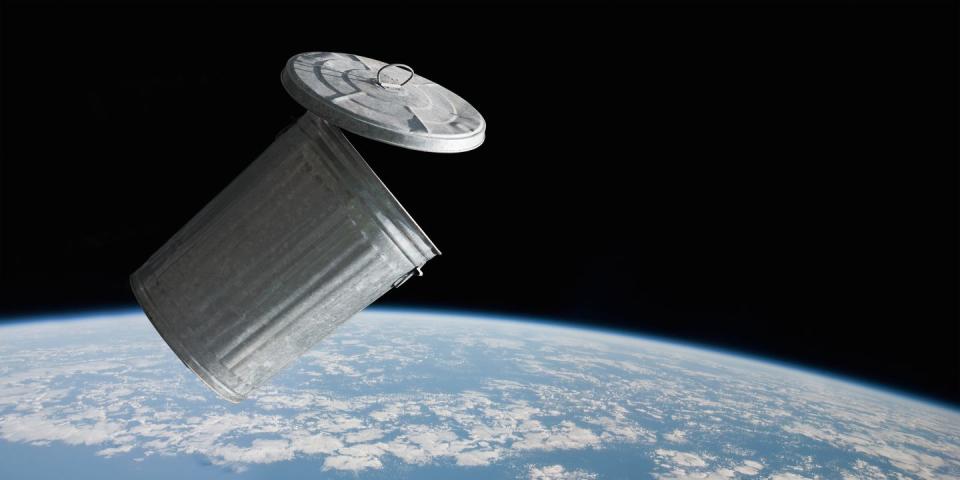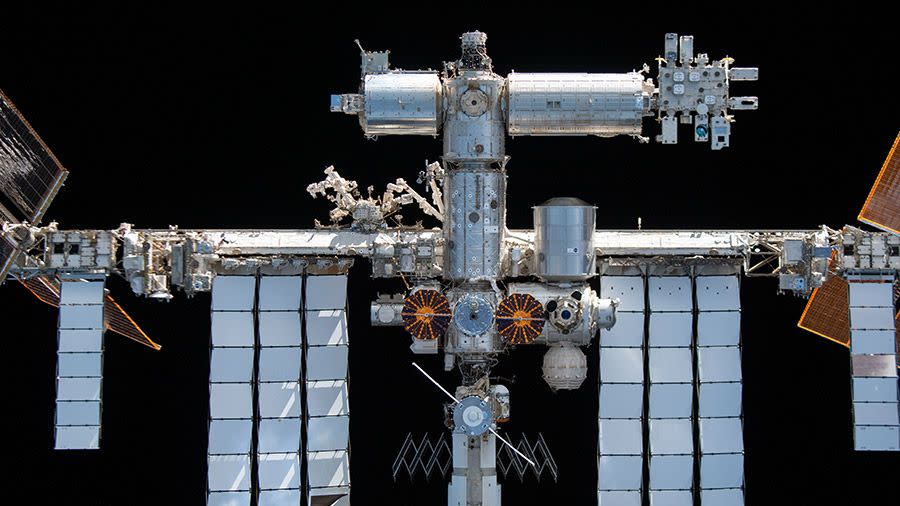The International Space Station Just Swerved Some Space Junk Because Russia Blew Up a Satellite

On Monday, the International Space Station had to fire its thrusters for over five minutes to avoid space junk.
Russia used a missile to blow up a Soviet satellite as part of a test in 2021, creating a daunting cloud of debris.
Space junk is a growing threat to both life on Earth and space operations.
Earlier this week, the International Space Station (ISS) had to fire up its thrusters for five minutes and five seconds to dodge a fragment of space junk left behind from a defunct Soviet satellite, Cosmos 1408. NASA called the move a “pre-determined debris avoidance maneuver.”
“Without the maneuver, NASA predicted that the fragment could have passed within about three miles from the station,” the space agency says in an October 24 statement.
🚀 Science explains the world around us. We’ll help you make sense of it all—join Pop Mech Pro.
But the ISS never should have had to swerve from the debris field in the first place.
Cosmos 1408 was a Soviet Electronic and Signal Intelligence Tselina-D satellite originally designed to determine the precise location, activity, and other details of enemy radio emitters. This type of espionage was known as electronic intelligence, or ELINT. The satellite stored data onboard and Soviet ground stations downloaded it. It operated for about two years before it became inactive.
In November 2021, Russia conducted a widely criticized anti-satellite test on Cosmos 1408 that left behind an estimated 1,500 pieces of space junk. According to the Carnegie Endowment for International Peace, this was the third such test—by any country—since 2007. In April, the U.S. government announced that it will not conduct destructive anti-satellite weapons tests, which spread dangerous “space junk” in low-Earth orbit.
“This test underscores the pressing need to develop new international norms and rules of behavior in space,” Ankit Panda, the Stanton Senior Fellow in the Nuclear Policy Program at the Carnegie Endowment for International Peace, said in a blog post last November. “It should further galvanize international efforts to ban this sort of weapons testing, which has significant negative consequences for the space environment near Earth.”
The U.S. Space Command immediately denounced the 2021 test, as well. At the time, U.S. Army General James Dickinson called the move a “deliberate disregard for the security, safety, stability, and long-term sustainability of the space domain for all nations.”
Dickinson went on to add that the debris would continue to pose a threat to activities in outer space for years to come, putting satellites and space missions at risk, as well as forcing more collision-avoidance maneuvers. “Space activities underpin our way of life,” he says, “and this kind of behavior is simply irresponsible.”

NASA’s October 24 debris-avoidance maneuver increased the station’s altitude by two-tenths of a mile at apogee (the farthest point in an orbit around Earth) and eight-tenths of a mile at perigee (the closest point in an orbit around Earth). The operation had no impact on station operations, NASA says in its statement. That’s not altogether surprising, given that the ISS typically moves at least once per year to avoid the path of debris—even if it was designed to take on impacts of junk up to 1 centimeter in diameter.
Space junk is becoming a growing concern both in space and on Earth. A recent study published in Nature Astronomy pointed to a 10 percent rise in the risk of space debris killing someone on Earth due to the sheer amount of detritus in space.
NASA reports that about 100 million pieces larger than a millimeter float in space: about 500,000 objects between 1 centimeter and 10 centimeters in diameter, and at least 25,000 pieces larger than 10 centimeters. That’s a lot of debris already in space without Russian missiles blowing up satellites for defense testing.
The build-up of space junk has officials across the world concerned. While that hasn’t led to strict rules on reducing space junk, guidelines are emerging that are focused on updating design standards meant to reduce the addition of “shedding” material. They also call for moving unused satellites into a “graveyard orbit.”
Additional reporting by Courtney Linder.
You Might Also Like
